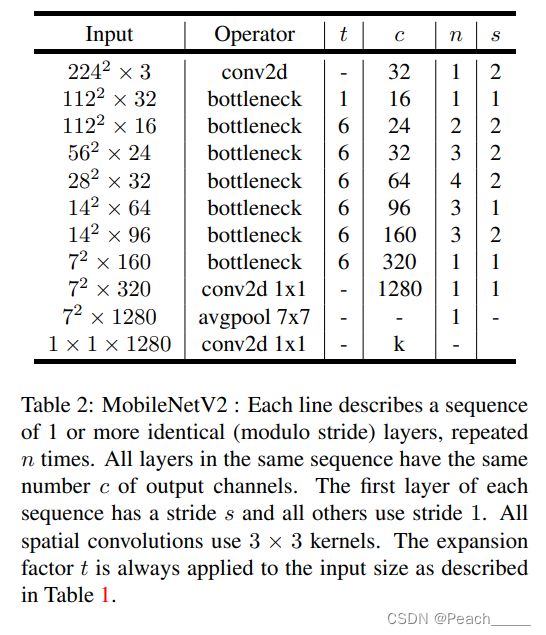MobileNet V2模型——pytorch实现
论文传送门:https://arxiv.org/pdf/1801.04381.pdf
MobileNet V2的目的:对图片进行特征提取,依据特征进行分类。(也可以作为backbone完成检测和分割任务)
MobileNet V2的优点:相较于V1,模型更小,精度更高。
MobileNet V2的方法:
①使用倒置残差结构(Inverted Residuals),1x1卷积升维+3x3深度卷积+1x1卷积降维;
②结构最后一层使用线性层(Linear Bottlenecks),不再进行ReLU6激活函数。
Inverted residual block 与 Residual block 的区别:
Inverted residual block:1x1ConvBNReLU6(升维)+3x3DepthwiseConvBNReLU6+1x1ConvBN(降维)+x;
Residual block:1x1ConvBNReLU(降维)+3x3ConvBNReLU+1x1ConvBN(升维)+x+ReLU;
Inverted residual block的结构:(只有深度卷积步长为1且结构前后通道数不变时进行残差边连接)
MobileNet V2的结构:卷积块+不断堆叠的倒置残差结构+卷积块+平均池化+卷积
注:如想使用预训练权值,请参考pytorch官方实现代码。
import torch
import torch.nn as nn
def conv_block(in_channel, out_channel, kernel_size=3, strid=1, groups=1): # 定义卷积块,conv+bn+relu6
padding = 0 if kernel_size == 1 else 1 # 计算padding
return nn.Sequential(
nn.Conv2d(in_channel, out_channel, kernel_size, strid, padding=padding, groups=groups, bias=False), # conv
nn.BatchNorm2d(out_channel), # bn
nn.ReLU6(inplace=True) # relu6
)
class InvertedResidual(nn.Module): # 定义倒置残差结构,Inverted Residual
def __init__(self, in_channel, out_channel, strid, t=6): # 初始化方法
super(InvertedResidual, self).__init__() # 继承初始化方法
self.in_channel = in_channel # 输入通道数
self.out_channel = out_channel # 输出通道数
self.strid = strid # 步长
self.t = t # 中间层通道扩大倍数,对应原文expansion ratio
self.hidden_channel = in_channel * t # 计算中间层通道数
layers = [] # 存放模型结构
if self.t != 1: # 如果expansion ratio不为1
layers += [conv_block(self.in_channel, self.hidden_channel, kernel_size=1)] # 添加conv+bn+relu6
layers += [conv_block(self.hidden_channel, self.hidden_channel, strid=self.strid, groups=self.hidden_channel),
# 添加conv+bn+relu6,此处使用组数等于输入通道数的分组卷积实现depthwise conv
conv_block(self.hidden_channel, self.out_channel, kernel_size=1)[
:-1]] # 添加1x1conv+bn,此处不再进行relu6
self.residul_block = nn.Sequential(*layers) # 倒置残差结构块
def forward(self, x): # 前传函数
if self.strid == 1 and self.in_channel == self.out_channel: # 如果卷积步长为1且前后通道数一致,则连接残差边
return x + self.residul_block(x) # x+F(x)
else: # 否则不进行残差连接
return self.residul_block(x) # F(x)
class MobileNetV2(nn.Module): # 定义MobileNet v2网络
def __init__(self, num_classes): # 初始化方法
super(MobileNetV2, self).__init__() # 继承初始化方法
self.num_classes = num_classes # 类别数量
self.feature = nn.Sequential( # 特征提取部分
conv_block(3, 32, strid=2), # conv+bn+relu6,(n,3,224,224)-->(n,32,112,112)
InvertedResidual(32, 16, strid=1, t=1), # inverted residual block,(n,32,112,112)-->(n,16,112,112)
InvertedResidual(16, 24, strid=2), # inverted residual block,(n,16,112,112)-->(n,24,56,56)
InvertedResidual(24, 24, strid=1), # inverted residual block,(n,24,56,56)-->(n,24,56,56)
InvertedResidual(24, 32, strid=2), # inverted residual block,(n,24,56,56)-->(n,32,28,28)
InvertedResidual(32, 32, strid=1), # inverted residual block,(n,32,28,28)-->(n,32,28,28)
InvertedResidual(32, 32, strid=1), # inverted residual block,(n,32,28,28)-->(n,32,28,28)
InvertedResidual(32, 64, strid=2), # inverted residual block,(n,32,28,28)-->(n,64,14,14)
InvertedResidual(64, 64, strid=1), # inverted residual block,(n,64,14,14)-->(n,64,14,14)
InvertedResidual(64, 64, strid=1), # inverted residual block,(n,64,14,14)-->(n,64,14,14)
InvertedResidual(64, 64, strid=1), # inverted residual block,(n,64,14,14)-->(n,64,14,14)
InvertedResidual(64, 96, strid=1), # inverted residual block,(n,64,14,14)-->(n,96,14,14)
InvertedResidual(96, 96, strid=1), # inverted residual block,(n,96,14,14)-->(n,96,14,14)
InvertedResidual(96, 96, strid=1), # inverted residual block,(n,96,14,14)-->(n,96,14,14)
InvertedResidual(96, 160, strid=2), # inverted residual block,(n,96,14,14)-->(n,160,7,7)
InvertedResidual(160, 160, strid=1), # inverted residual block,(n,160,7,7)-->(n,160,7,7)
InvertedResidual(160, 160, strid=1), # inverted residual block,(n,160,7,7)-->(n,160,7,7)
InvertedResidual(160, 320, strid=1), # inverted residual block,(n,160,7,7)-->(n,320,7,7)
conv_block(320, 1280, kernel_size=1) # conv+bn+relu6,(n,320,7,7)-->(n,1280,7,7)
)
self.classifier = nn.Sequential( # 分类部分
nn.AdaptiveAvgPool2d(1), # avgpool,(n,1280,7,7)-->(n,1280,1,1)
nn.Conv2d(1280, self.num_classes, 1, 1, 0) # 1x1conv,(n,1280,1,1)-->(n,num_classes,1,1),等同于linear
)
def forward(self, x): # 前传函数
x = self.feature(x) # 提取特征
x = self.classifier(x) # 分类
return x.view(-1, self.num_classes) # 压缩不需要的维度,返回分类结果,(n,num_classes,1,1)-->(n,num_classes)

